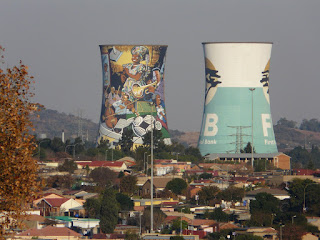It took 2 overnight flights to get here, but we made it with all of our luggage (all 26 lbs/person). We reached the hotel about 11 - time for a short nap and lunch before our tour of Soweto. This township created outside Johannesberg and the blacks were forced to move here during the apartheid years (1948-1993). A key landmark is the water cooling tower for the former coal powered electric plant. At the time, Soweto itself had no electricity, they just got the pollution.  Cooling Towers in the Center of Soweto
Cooling Towers in the Center of Soweto
 Cooling Towers in the Center of Soweto
Cooling Towers in the Center of SowetoThe world became aware of Soweto upon publication of a picture of a child killed during the protests of June 16, 1976. 566 people were killed that day because protesting the use of Afrikaner in the schools, rather than English.  1976 Photo
1976 Photo
Today, Soweto is a relatively quiet place, even with the disparity of economic conditions - millionaires living across the street from hostels holding 20 single men, next to elephant houses (the roof of which looks like the back of an elephant) where 3 families live in what we would call small single family homes. There is a lot of pollution, since many people use coal for heating and cooking.
Everyone was friendly - a kindergartener, who was all smiles, hanging on to our legs, or a high school girl our guide just stopped on the street, who told us how she was doing in school. We stopped and I tasted some cow's head, a local dish. Most of the school children know at least 3 languages (local African dialect, English, and Afrikaner) and our guide actually speaks all 11 official languages.

No comments:
Post a Comment